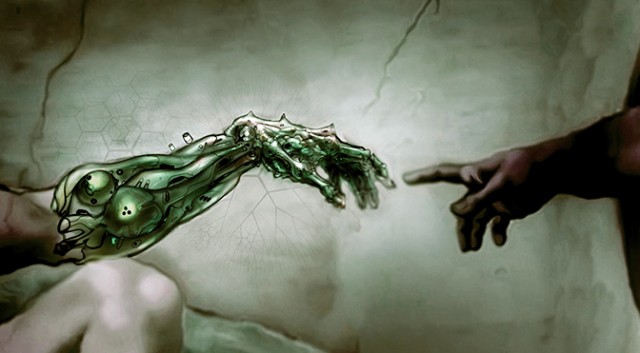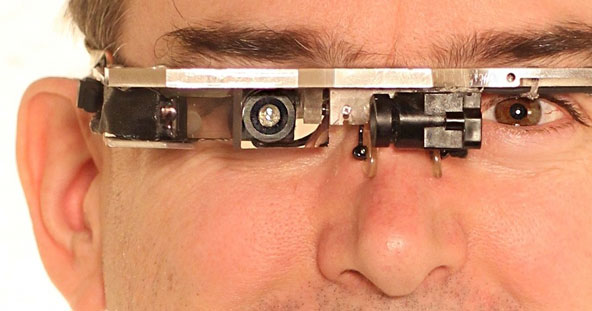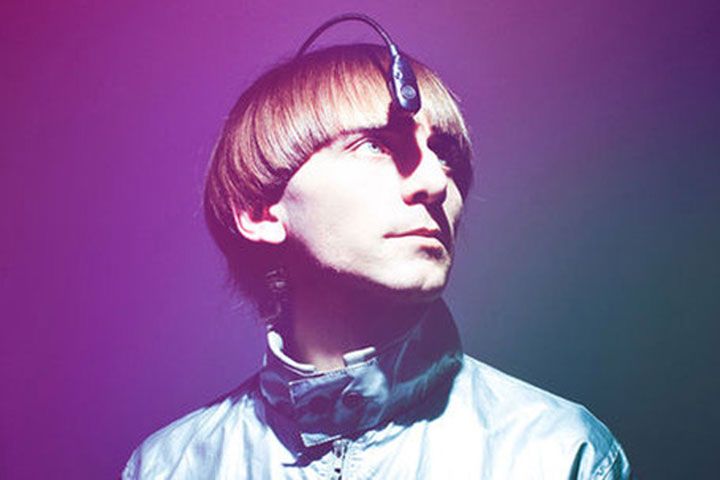
It’s known as Achromatopsia, a rare form of color blindness that effects one in thirty-five thousand people. For those living with this condition, everything appears only in terms of black and white. One such individual is Neil Harbisson. a Catalan-raised, British-born contemporary artist and cyborg activist who spent his formative years living in a world without color.
However, since 2004, he has been able to “hear” color with the help of a body modification that has provided with him with a "cybernetic third eye". This device, which is known as the “eyeborg”, is a permanently integrated piece of technology that translated the color spectrum into sound, and then transmits this information to Harbisson's brain.
Harbisson’s brain does not convert those sounds back into visual information, mind you; so he still doesn’t know exactly what the color blue looks like. But he knows what it sounds like. As he explained to an audience at a TED Talks segmen (see video below)t, he used to dress based on appearances. Now, he dresses in a way that sounds good. For example, the pink blazer, blue shirt and yellow pants he was wearing for the talk formed a C Major chord.
This may sound like an abstract replacement for actual color perception; but in many ways, the eyeborg surpasses human chromatic perception. For example, the device is capable of distinguishing 360 different hues, and allows Harbisson to hear the presence of ultraviolet and infrared energy. Because the device is a permanent part of his body, many have taken to calling Habrison "the world's first cyborg."
In addition, the abilities that it confers, which go beyond normal human perception to see non-visible wavelength of light, have led some to question whether or not Harbison is an example of the posthuman era that believed to be coming.

Posthumanism (or transhumanism) it should be noted, is an international movement with an eventual goal of fundamentally transforming the human condition by developing and making widely available technologies to greatly enhance human intellectual, physical, and psychological capacities.
In any case, the function of the eyeborg was described in the following way in an article by Nautilus entitled “Encounters with the Posthuman”:
"It transposes color into a continuous electronic beep, exploiting the fact that both light and sound are made up of waves of various frequencies. Red, at the bottom of the visual spectrum and with the lowest frequency, sounds the lowest, and violet, at the top, sounds highest. A chip at the back of Harbisson’s head performs the necessary computations, and a pressure-pad allows color-related sound to be conducted to Harbisson’s inner ear through the vibration of his skull, leaving his outer ears free for normal noise. Harbisson, who has perfect pitch, has learned to link these notes back to the colors that produced them."
Harbisson wants to find ways to fix devices like his eyeborg permanently to his skull, and recharge it with his blood. What’s more, Neil Harbisson is now the first person on the planet to have a passport photo that shows his cyborg nature. After a long battle with UK authorities, his passport now features a photo of him, eyeborg and all. And now, he is looking to help other cyborgs like himself gain more rights, mainly because of the difficulties such people have been facing in recent years.
These and other developments are what led Harbisson to found the Cyborg Foundation in 2010 - a society that is working to create cybernetic devices that compensate for and augment human senses. These include the “fingerborg” that replaces a finger with a camera, a “speedborg” that conveys how fast an object is moving with earlobe vibrations, and a “cybernetic nose” that allows people to perceive smells through electromagnetic signals.

In addition to helping people become cyborgs, the foundation claims to fight for cyborg rights. While this might sounds like something out of science fiction, the recent incidents against people with enhancements or portable computers are apparent indications that an organization of this kind may be necessary.
Consider the case of Steve Mann, the man recognized internationally to be “father of wearable computers”. Since the 1970’s, he has been working towards the creation of fully-portable, ergonomic computers that people can carry with them wherever they go. The result of this was the EyeTap, a wearable computer he invented in 1998 and then had grafted to his head. In July of 2012, he was ejected from a McDonald’s in Paris after several staff members tried to forcibly remove the wearable device.
And then in April of 2013, a bar in Seattle banned patrons from using Google Glass, declaring that “ass-kickings will be encouraged for violators.” Other businesses across the world have followed, fearing that people wearing these devices may be taking photos or video and posting it to the internet. Other incidents have since taken place, with business refusing service to Google Glass wearers, and even the occasional physical assault.
Essentially, Harbisson believes that recent technological advances mean there will be a rapid growth in the number of people with cybernetic implants in the near future, implants that will either assist them or give them enhanced abilities. As he said in a recent interview: "Our instincts and our bodies will change. When you incorporate technology into the body, the body will need to change to accommodate; it modifies and adapts to new inputs. How we adapt to this change will be very interesting."

Other human cyborgs include Stelarc, a performance artist who has implanted a hearing ear on his forearm; Kevin Warwick, the “world’s first human cyborg” who has an RFID chip embedded beneath his skin, allowing him to control devices such as lights, doors and heaters; and “DIY cyborg” Tim Cannon, who has a self-administered body-monitoring device in his arm.
And though they are still in the minority, the number of people who live with integrated electronic or bionic devices is growing. Ensure that the transition is accomplished as painlessly as possible is one of the founding principles of the Cyborg Foundation. According to their website, the organization’s mission statement is to: "help humans become cyborgs, to promote the use of cybernetics as part of the human body and to defend cyborg rights [whilst] encouraging people to create their own sensory extensions."
And as mind-controlled prosthetics, implants, and other devices meant to augment a person’s senses, faculties, and ambulatory ability are introduced, we can expect people to begin to actively integrate them into their bodies. Beyond correcting for injuries or disabilities, the increasing availability of such technology is also likely to draw people looking to enhance their natural abilities.
In short, the future is likely to be a place in which cyborgs are a common features of our society. The size and shape of that society is difficult to predict, but given that its existence is all but certain, we as individuals need to be able to address it. Not only is it an issue of tolerance, there’s also the need for informed decision-making when it comes to whether or not individuals need to make cybernetic enhancements a part of their lives.
For more information on the eyeborg and Project Cyborg, check out Harbisson’s website here. Neil Harbisson’s Project Cyborg promotional video is also available on Vimeo. And be sure to watch the video of Neil Harbisson at the TED Talks lecture:
And be sure to check out this video from Vodafone showing Neil Harbisson conduct his first "color concert":
Sources:
- cyborgism.wix.com/cyborg
- eyeborgproject.com/
- wearcam.org/steve.html
- stelarc.org/_.swf
- www.bbc.co.uk/news/technology-29992577
- mashable.com/2014/02/28/when-google-glass-haters-attack/
- www.ted.com/talks/neil_harbisson_i_listen_to_color?language=en#t-3914
- www.firsts.com/content/vodafone-firsts/home/Neil-Harbisson.html
- www.fastcoexist.com/1682031/this-cyborg-hears-colors-with-his-skull
- nautil.us/issue/1/what-makes-you-so-special/encounters-with-the-posthuman
- io9.com/the-first-person-in-the-world-to-become-a-government-re-1474975237
Image Credits:
- Neil Harbisson pics: Dan Wilton/The Red Bulletin
- Transhumanism: Mountain Vision
- Eyetap/Steve Mann: Glogger/Wikimedia Commons








